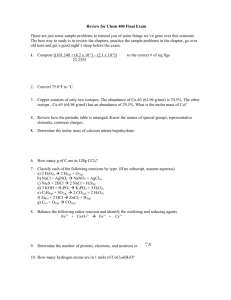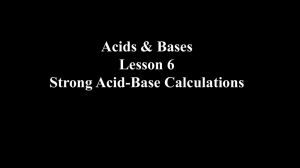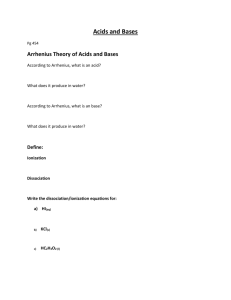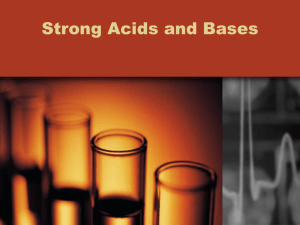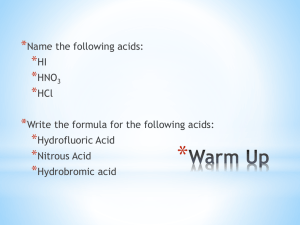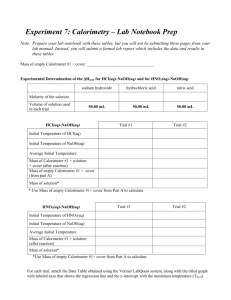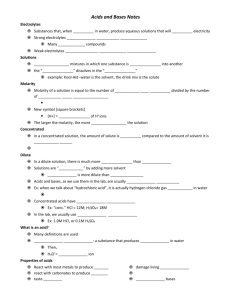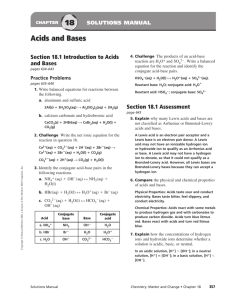Spring Final Review ANSWERS
advertisement
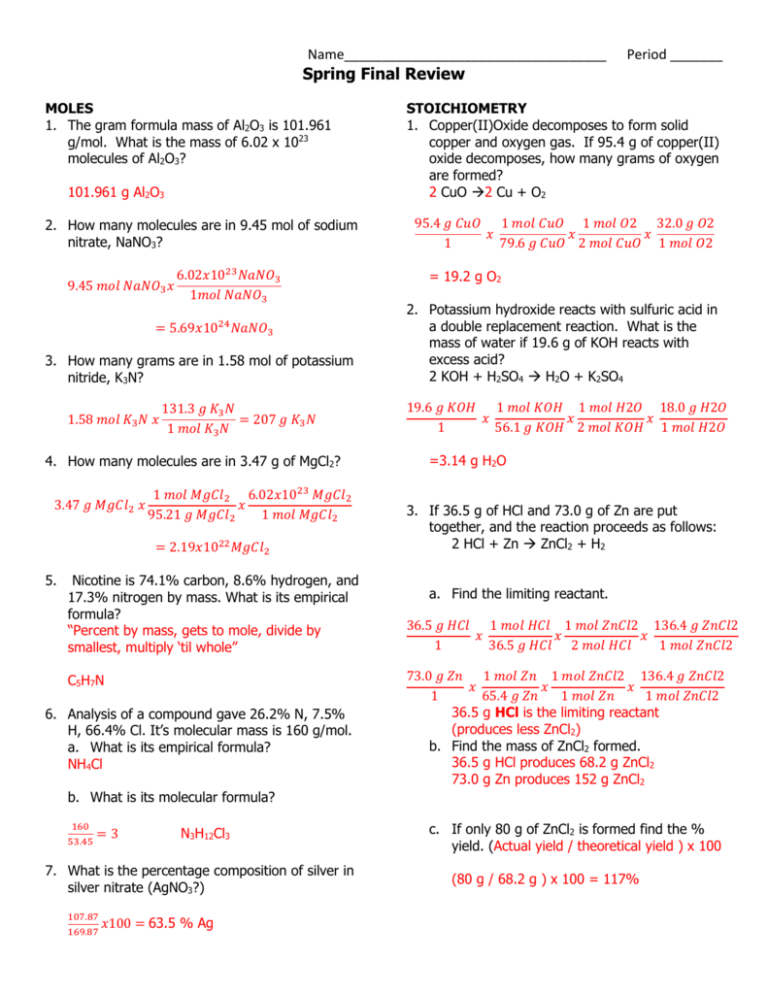
Name___________________________________ Period _______ Spring Final Review MOLES 1. The gram formula mass of Al2O3 is 101.961 g/mol. What is the mass of 6.02 x 1023 molecules of Al2O3? 101.961 g Al2O3 2. How many molecules are in 9.45 mol of sodium nitrate, NaNO3? 9.45 𝑚𝑜𝑙 𝑁𝑎𝑁𝑂3 𝑥 6.02𝑥1023 𝑁𝑎𝑁𝑂3 1𝑚𝑜𝑙 𝑁𝑎𝑁𝑂3 24 = 5.69𝑥10 𝑁𝑎𝑁𝑂3 3. How many grams are in 1.58 mol of potassium nitride, K3N? 1.58 𝑚𝑜𝑙 𝐾3 𝑁 𝑥 131.3 𝑔 𝐾3 𝑁 = 207 𝑔 𝐾3 𝑁 1 𝑚𝑜𝑙 𝐾3 𝑁 4. How many molecules are in 3.47 g of MgCl2? 3.47 𝑔 𝑀𝑔𝐶𝑙2 𝑥 1 𝑚𝑜𝑙 𝑀𝑔𝐶𝑙2 6.02𝑥1023 𝑀𝑔𝐶𝑙2 𝑥 95.21 𝑔 𝑀𝑔𝐶𝑙2 1 𝑚𝑜𝑙 𝑀𝑔𝐶𝑙2 = 2.19𝑥1022 𝑀𝑔𝐶𝑙2 5. Nicotine is 74.1% carbon, 8.6% hydrogen, and 17.3% nitrogen by mass. What is its empirical formula? “Percent by mass, gets to mole, divide by smallest, multiply ‘til whole” C5H7N 6. Analysis of a compound gave 26.2% N, 7.5% H, 66.4% Cl. It’s molecular mass is 160 g/mol. a. What is its empirical formula? NH4Cl STOICHIOMETRY 1. Copper(II)Oxide decomposes to form solid copper and oxygen gas. If 95.4 g of copper(II) oxide decomposes, how many grams of oxygen are formed? 2 CuO 2 Cu + O2 95.4 𝑔 𝐶𝑢𝑂 1 𝑚𝑜𝑙 𝐶𝑢𝑂 1 𝑚𝑜𝑙 𝑂2 32.0 𝑔 𝑂2 𝑥 𝑥 𝑥 1 79.6 𝑔 𝐶𝑢𝑂 2 𝑚𝑜𝑙 𝐶𝑢𝑂 1 𝑚𝑜𝑙 𝑂2 = 19.2 g O2 2. Potassium hydroxide reacts with sulfuric acid in a double replacement reaction. What is the mass of water if 19.6 g of KOH reacts with excess acid? 2 KOH + H2SO4 H2O + K2SO4 19.6 𝑔 𝐾𝑂𝐻 1 𝑚𝑜𝑙 𝐾𝑂𝐻 1 𝑚𝑜𝑙 𝐻2𝑂 18.0 𝑔 𝐻2𝑂 𝑥 𝑥 𝑥 1 56.1 𝑔 𝐾𝑂𝐻 2 𝑚𝑜𝑙 𝐾𝑂𝐻 1 𝑚𝑜𝑙 𝐻2𝑂 =3.14 g H2O 3. If 36.5 g of HCl and 73.0 g of Zn are put together, and the reaction proceeds as follows: 2 HCl + Zn ZnCl2 + H2 a. Find the limiting reactant. 36.5 𝑔 𝐻𝐶𝑙 1 𝑚𝑜𝑙 𝐻𝐶𝑙 1 𝑚𝑜𝑙 𝑍𝑛𝐶𝑙2 136.4 𝑔 𝑍𝑛𝐶𝑙2 𝑥 𝑥 𝑥 1 36.5 𝑔 𝐻𝐶𝑙 2 𝑚𝑜𝑙 𝐻𝐶𝑙 1 𝑚𝑜𝑙 𝑍𝑛𝐶𝑙2 73.0 𝑔 𝑍𝑛 1 𝑚𝑜𝑙 𝑍𝑛 1 𝑚𝑜𝑙 𝑍𝑛𝐶𝑙2 136.4 𝑔 𝑍𝑛𝐶𝑙2 𝑥 𝑥 𝑥 1 65.4 𝑔 𝑍𝑛 1 𝑚𝑜𝑙 𝑍𝑛 1 𝑚𝑜𝑙 𝑍𝑛𝐶𝑙2 36.5 g HCl is the limiting reactant (produces less ZnCl2) b. Find the mass of ZnCl2 formed. 36.5 g HCl produces 68.2 g ZnCl2 73.0 g Zn produces 152 g ZnCl2 b. What is its molecular formula? 160 53.45 =3 N3H12Cl3 7. What is the percentage composition of silver in silver nitrate (AgNO3?) 107.87 𝑥100 169.87 = 63.5 % Ag c. If only 80 g of ZnCl2 is formed find the % yield. (Actual yield / theoretical yield ) x 100 (80 g / 68.2 g ) x 100 = 117% Name___________________________________ Period _______ THERMOCHEMISTRY 1. If you burn a 30.0 g Cheeto in a bomb calorimeter containing 500 g of water (Cp = 4.18 J/g°C), and the temperature increases by 30 degrees Celsius, how many joules of energy are in the chips? Q = (500g)(30°C)(4.18 J/g°C )= 62700 J 2. What is the molarity of NaOH in which 19.2 g of solute is dissolved in 160 ml of solution? 19.2 𝑔 𝑁𝑎𝑂𝐻 1 𝑚𝑜𝑙 𝑁𝑎𝑂𝐻 𝑥 = .48 𝑚𝑜𝑙 1 40.0 𝑔 𝑁𝑎𝑂𝐻 2. The temperature of an 8.0 g sample of metal changed from 250 to 500 C when it absorbed 420J of heat. What is the specific heat of this sample? 𝑄 420 𝐽 Cp = 𝑚∆𝑇 = (8.0 𝑔)(25°C) = 2.1 J/g°C 3. How many grams of NaCl would be required to make 300 ml of a 0.5 M solution of NaCl? 𝑚𝑜𝑙 𝑀= 𝐿 𝑚𝑜𝑙 = 𝑀𝑥𝐿 = 0.5 𝑀 𝑥 0.300 𝐿 = .15 𝑚𝑜𝑙 0.15 𝑚𝑜𝑙 58.8 𝑔 𝑁𝑎𝐶𝑙 𝑥 = 8.85 𝑔 𝑁𝑎𝐶𝑙 1 1 𝑚𝑜𝑙 𝑁𝑎𝐶𝑙 3. True of False a. __F__Heat moves from a colder object to a warmer one. b. __T___∆H refers to a reaction while ∆Hf° refers to a compound c. __F___If the heat involved in a chemical reaction has a negative sign, heat is lost to the surroundings and the reaction is endothermic d. __F___A process that absorbs heat is an exothermic process. e. __T___ΔH is zero for a free element (O2, Na, etc.) 4. Label the following reactions as either endothermic or exothermic. a. __Exo____ 2 H2 + O2 2 H2O + energy b. __Endo____ CO2 + H2O + energy CH2O + O2 c. ___Exo____ CH4 + 2 O2 CO2 + 2 H2O +energy 5. A hot metal cube is placed into cool water. Explain what happens to the temperature of the water and the metal cube? Heat is lost from the metal cube and gained by the water. The temperature of the metal cube decreases as the water temperature increases. SOLUTIONS 1. What is the molarity of nitric acid in which 6.3 g of HNO3 is dissolved in 500 ml of solution? 6.3𝑔 𝐻𝑁𝑂3 1 𝑚𝑜𝑙 𝑥 = 0.1 𝑚𝑜𝑙 𝐻𝑁𝑂3 1 63𝑔 𝐻𝑁𝑂3 0.1 𝑚𝑜𝑙 𝐻𝑁𝑂3 = 0.2 𝑀 . 500 𝐿 . 48 𝑚𝑜𝑙 = 3𝑀 . 160 𝐿 4. How many mL of 3.0 M HCl would be needed to make 2000 ml of 0.5 M HCl? 𝑉1 𝑀1 = 𝑉2 𝑀2 𝑉2 𝑀2 𝑉1 = 𝑀1 (2000 𝑚𝐿) (0.5 𝑀) 𝑉1 = 3.0 𝑀 𝑉1 = 333 𝑚𝐿 5. A lab procedure calls for 3.2L of solution. This solution is made by adding water to 0.0500 L of 16 M H2SO4. What concentration do you end up with by doing this? 𝑉1 𝑀1 = 𝑉2 𝑀2 𝑉1 𝑀1 𝑀2 = 𝑉2 (0.0500 𝐿)(16 𝑀) 𝑀2 = ( = 0.25 𝑀 3.2 𝐿 6. How much 1.43 M HCl will be needed to make 1.5 L of 1.2 M HCl? 𝑉1 𝑀1 = 𝑉2 𝑀2 𝑉2 𝑀2 𝑉1 = 𝑀1 (1.5 𝐿)(1.2𝑀) 𝑉1 = = 1.26 L 1.43 𝑀 7. Which of the following is soluble (Only one is correct)? a. Na2CrO4 b. AgBr c. HgSO4 d. AlPO4 8. You mix Mg(NO3)2 and Na2CO3. Will you get a precipitate? If so, what is the formula? a. No. Name___________________________________ b. Yes, NO3CO3 c. Yes, MgCO3 9. Which of the following reactions will produce a precipitate? (only one is correct): a. Ca(OH)2+NaClCaCl2 + NaOH Period _______ 15. At what temperature can NH3 and KNO3 dissolve the same amount of solute? a. 43°C b. 28°C c. 8°C d. 24°C b. AlBr3 + AgClO AgBr + Al(ClO)3 c. MgBr2 + Al(NO3)3 AlBr3 + Mg(NO3)2 10. All of these can increase the rate at which a solid dissolves in water except — a. using smaller crystals of the solid b. stirring the water c. increasing the temperature of the water d. using larger crystals of the solid 11. Which set of conditions would increase the solubility of salt (solid) in water? a. Low temperature, small particle size b. Low temperature, large particle size c. High temperature, small particle size d. High temperature, large particle size 12. True or False: Correct the statement if it is false. a. ___F__Water is nonpolar. b. ___T___Water is able to dissolve ionic compounds due to its slight positive and negative charges. c. __F____Water is universal compound solvent. d. ___F___Water molecules have strong forces of interaction due to oxygen hydrogen bonding. 13. Mr. Philpott prepares an unsaturated solution of sodium nitrate. This means – a. That no more sodium nitrate can be added to the solution b. That more sodium nitrate can be added to the solution c. That there is more than the maximum amount of sodium nitrate in the solution. d. None of the above 14. What happens to a light bulb connected to an aqueous solution when you have a strong electrolyte? Weak electrolyte? Nonelectrolyte? Strong: Bright Weak: Dim Non: Off ACIDS AND BASES 1. Identify the parts of the neutralization reaction (acid, base, salt, and water): a. Mg(OH)2 + H2SO4 Base Acid b. H3PO4 + NaOH Acid MgSO4 + H2O Base Salt Water Na3PO4 + H2O Salt Water 2. A solution with a pH of 4 is how many more times acidic than a solution with a pH of 7? 7-4= 3 103 = 10 x 10 x 10 = 1000 3. A solution with a pH of 14 is how many more times basic than a solution with a pH of 13? 14-13 = 101 = 10 4. True or False? _T__Strong acids almost completely dissociate in water while weak acids partially dissociate in water. _F__Strong acids partially dissociate in water while weak acids almost completely dissociate in water. Name___________________________________ _F__Weak acids always have a lower pH than strong acids. __F_Strong acids produce hydroxide ions in solution and weak acids produce hydrogen ions in solution. 5. What are the pH and pOH of a solution with a [H+] of 3.64 x 10-7? pH = -log(H+] pH = -log(3.64x10-7) = 6.43 = pH pOH = 14 – pH = 14 - 6.43 = 7.57 6. What is the pOH of a solution in which 0.26 moles of sodium hydroxide (NaOH) was dissolved in .457 L of water. 𝑀= 0.26 𝑚𝑜𝑙 .457 𝐿 = 0.568 = [𝑂𝐻 − ] pOH = -log (OH-) = - log(.568) = 0.246 7. Complete the tables below Acids, Bases, or Both Property Donates protons (H+) Causes blue litmus paper to turn red Electrolytes Sour taste Causes red litmus paper to turn blue Bitter taste [ H+] = 1.0 x 10-2 Electron donor Acid Acid Both Acid Base Base Acid (Pre-AP only) Base Period _______ GAS LAWS 1. True / False a. __T__ According to the kinetic-molecular theory, particles of matter are in continual motion b. __F__ According to the kinetic-molecular theory, matter is composed of very large particles c. __F__ According to the kinetic-molecular theory, the total energy of colliding particles is changing all the time. 2. You are stuck in a room with two horrible smelling gases. One is a bad smell from a cat’s litter box due to ammonia, NH3, with a molecular weight of 17g/mol and the other is an inexpensive French perfume with a molecular weight of 170 g/mol. Which gas molecules will reach your nose first? a) ammonia b) inexpensive perfume c) both + [H ] [OH-] pH Acid, Base or Neutral? 1.00 x 1.00x10 4 Acid 10 10-4 7 1x10-7 1x10-7 Neutral 3. How can you slow down the time it takes the molecules of ammonia and inexpensive perfume to reach your nose? a) increase the temperature of the room b) decrease the temperature of the room c) it doesn’t matter 4. 257 mL of oxygen in a gas tube goes from 17°C to 42°C from being out in the sun. The pressure in the tube increases from 3.6 atm to 4.5 atm. What is the new volume of the tube? (3.6)(257)(315) V2 = (290)(4.5) = 223.32 mL = 220 mL 5. A .450 L sample of fluorine gas is at 27˚C and 216 kPa. How many moles of fluorine gas is this? (216)(.450) n = (8.314)(300) = 0.039 mol Equations and Conversion Factors 𝟔. 𝟎𝟐 𝒙 𝟏𝟎𝟐𝟑 𝒎𝒐𝒍𝒆𝒄𝒖𝒍𝒆𝒔 𝟏 𝒎𝒐𝒍 pH = -log[H+] pOH = -log[OH-] pH + pOH = 14
